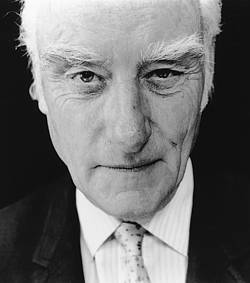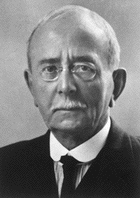 "More than any other modern thinker -- even Freud and Marx -- this affable old-world naturalist from the minor Shropshire gentry has transformed the way we see ourselves on this planet."
"More than any other modern thinker -- even Freud and Marx -- this affable old-world naturalist from the minor Shropshire gentry has transformed the way we see ourselves on this planet." -- Desmond & Moore.
A mediocre student at Cambridge; a tentative young adult still in search of a career, somewhat of a disappointment to his prosperous, industrious family; and a devout creationist who occasionally suffered derision for his habit of quoting the Bible as unanswerable authority -- these facts seem to be at odds with the image of Charles Darwin, the most influential thinker of the 19th century, the scary, long-bearded radical who (as his critics, then and now, might say) reached down and plucked the Book of
Genesis out of the ground by the roots and planted grasping science in its place.
Born on this day in 1809 in Shrewsbury, England, the grandson of two illustrious men of science and industry, naturalist Erasmus Darwin and pottery magnate Josiah Wedgwood -- the arc of this unpromising man's life, so difficult to calculate at age 22, was ultimately formed by inexhaustible curiosity about the natural environment and its deeper meanings than any desire for influence. As a youth he attended Samuel Butler's Shrewsbury School and did very poorly with the classical curriculum; entered Edinburgh University at age 16 to study medicine (to follow in the footsteps of his father), but couldn't bear to watch surgeries; and enrolled in Christ College, Cambridge at age 19 to study for the clergy, which he did listlessly.
All the while, however, Darwin enthusiastically indulged his interest in nature: at Shrewsbury, he spent much of his time collecting rocks and birds' eggs; at Edinburgh, he fell in with a taxidermist, as well as zoologist Robert Grant, who first exposed him to Lamarck's theory of heredity; and at Cambridge, he collected beetles and went on nature walks with botanist John Stevens Henslow.
Upon graduation, at Henslow's recommendation he was offered the chance to see the world before settling down in some quiet corner of England as a parish parson, and he signed on as an unpaid naturalist on the
H.M.S. Beagle, which was set to survey the coast of Tierra del Fuego, Chile and Peru, and the South Sea Islands. His male-ingénue errand was to provide well-bred intellectual companionship to the ship's captain and to make a few notes about local flora and fauna; but the voyage transformed Darwin's image of himself.
He did make copious notes about the geology (heavily influenced by Charles Lyell, whose
Principles of Geology he read while sailing), the flora and the fauna, but he also rode with the gauchos across the Pampas; encountered an armed revolt in Montevideo; and waded upstream through thick-jungled river valleys, helping to tow the ship's reconnaissance boats. In the Galapagos Islands, he became particularly interested in the slight variations in bird and tortoise species which seemed peculiarly suited to their distinct habitats from island to island, and made observations of them which would form part of the argument for his theory of evolution 20 years later.
Upon returning to England in 1836, Darwin suddenly had a calling in life; he was quickly accepted into the British scientific fraternity and began to establish his scientific reputation with
Journal of Researches into the Geology and Natural History of the Various Countries Visited by H.M.S. Beagle (1839),
The Zoology of the Voyage of H.M.S. Beagle (1840) and
The Structure and Distribution of Coral Reefs (1842), all accessible and vividly written works of traditional science.
As early as 1838, however, while reading Thomas Malthus, Darwin recalled the birds and tortoises of the Galapagos and conceived the idea of natural selection -- the process by which certain advantageous traits are conserved and multiplied through reproduction which enables the adaptation of an organism to its environment. Through natural selection, Darwin surmised, the evolution of organisms unfolds. He kept silent, however, realizing that the scientific community, let alone the world at large, was not ready to accept a theory of such earthbound determinism; in England and elsewhere during the early 19th century, the hand of God was said to be seen in the spontaneous creation of species variations, and Darwin's theory would be considered blasphemous.
He continued to collect evidence for the theory, however, and drafted some preliminary sketches of it which he shared with his friends, Lyell and the botanist Joseph Dalton Hooker. Despite their urging, he would not publish the theory, until in 1858 when he received a paper from an amateur naturalist, Alfred Russell Wallace, which proposed the same theory which Darwin had been working on for 20 years. After Darwin's precedence was proven, the 2 presented separate papers on the subject before the Linnaean Society, after which Darwin published his classic elaboration on natural selection,
The Origin of Species (1859).
The book was an immediate best-seller, and most of the scientific community (with some notable exceptions, such as Louis Agassiz and Darwin's old mentor Henslow) accepted his view; but as Darwin had predicted the orthodox clergy saw the theory as completely inconsistent with
Genesis and ridiculed him. Broader-minded clerics, then as now, saw the trace of evolution suggested by Darwin as bold evidence of God's continuing creative presence in the world. Darwin's friend, T.H. Huxley (later known as "Darwin's bulldog") took up the defense, notably chastising the Bishop of Oxford for his narrow-mindedness, saying that he would "rather be related to an ape than to a man of proven ability who used his brains to pervert the truth."
For his own part, Darwin returned to writing and solving the issues at the edge of his theory. In
The Variations of Animals and Plants Under Domestication (1868), Darwin advanced the theory of "pangenesis" -- the notion that cells throughout the body contribute instructions to reproductive cells -- to explain the workings of heredity; the theory was later disproven as the work of Gregor Mendel and Thomas Hunt Morgan eventually came to light.
His Descent of Man (1871) attempted to apply natural selection to moral and spiritual traits, stimulating the work already begun by sociologist Herbert Spencer and launching a host of imitators noodling on the psychological and political implications of evolutionary theory.
Still a controversial figure at the time of his death on April 19, 1882, 20 members of Parliament nonetheless immediately moved to request that he be buried in a place of honor at Westminster Abbey; his tomb is located just a few paces away from those of
Isaac Newton and Michael Faraday. The theory of evolution has had a profound influence on numerous modern scientific disciplines, as well as popular knowledge and political philosophy, and if anything has gained momentum as microbiology and genetics have provided it with more complex underpinnings.
Labels: Biologists and Physiologists, Evolution










